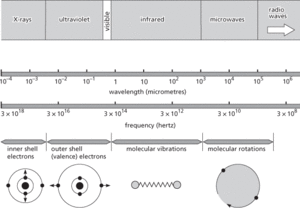The study of methods of producing and analysing spectra using spectroscopes, spectrometers, spectrographs, and spectrophotometers. The interpretations of the spectra so produced can be used for chemical analysis, for examining atomic and molecular energy levels and molecular structures, and for determining the composition and motions of celestial bodies (see redshift). See also Auger spectroscopy; laser spectroscopy.
https://www.nist.gov/pml/atomic-spectra-database The NIST atomic-spectra database
https://www.nist.gov/pml/handbook-basic-atomic-spectroscopic-data Handbook of Basic Atomic Spectroscopic Data
http://www.chemteam.info/Chem-History/Kirchhoff-Bunsen-1860.html Original paper on spectroscopy by Kirchhoff and Bunsen in Annalen der Physik und der Chemie (1860)
The technique of obtaining and studying the spectra of celestial bodies, from which their compositions, physical properties, and motions can be determined. The instrument used is a spectrograph, a form of spectroscope in which the spectrum is recorded with a detector (a CCD in the case of optical spectroscopy). Three main types of spectrum are observed in astronomical sources: a continuum, or continuous spectrum, consisting of an unbroken band of colours; an emission spectrum, which consists of bright lines; and an absorption spectrum, consisting of dark lines crossing a continuum. However, many classes of objects show both absorption and emission lines superimposed on a continuum, reflecting a range of physical conditions in the source. Study of a star’s spectrum allows its temperature, luminosity, and size to be determined (see spectral classification). The displacement of spectral lines (the Doppler shift) reveals the object’s movement along the line of sight (its radial velocity).
X-ray spectroscopy concentrates on hot, highly energetic objects. Emission lines are detected from old supernova remnants, coronae of hot stars, and accretion disks. The field of cosmic X-ray spectroscopy began in earnest with the launch of the Chandra X-ray Observatory and XMM-Newton in 1999 and 2000 respectively. Both produce high-resolution X-ray spectra combined with high-sensitivity X-ray CCD detectors.
Ultraviolet spectroscopy was pioneered by the Copernicus satellite, launched in 1972, and continued by the long-lived International Ultraviolet Explorer (IUE) satellite (1978–96). This wavelength range is of importance because the resonance lines of many atoms and ions lie in the ultraviolet. This region is especially useful in studies of the diffuse interstellar medium and of hot stars and their stellar winds. The Hubble Space Telescope has better resolution and much improved sensitivity compared to IUE, while the Far Ultraviolet Spectroscopic Explorer (FUSE) satellite operated at wavelengths shorter than those accessible to either IUE or HST.
Optical spectroscopy is the key to the widest range of astronomical studies because there are far more telescopes operating in this region. It is also usually possible to obtain much higher spectral resolution than at other wavelengths, making it possible to study line profiles (for temperature and density information) and velocities (e.g. in binaries, from which their masses can be calculated). Multi-object spectroscopy has become commonplace in the optical region while still not widely applied in other spectral regions.
Infrared spectroscopy is a rapidly developing area. The first attempts at infrared spectroscopy used narrow-band filters with a tunable passband, the detector being a simple bolometer. The advent of infrared-sensitive arrays, analogous to optical CCDs but constructed of indium antimonide or mercury cadmium telluride, has allowed the development of grating spectrometers which are similar to their visual counterparts, except that the grating is cooled to reduce thermal noise. Fourier transform spectroscopy is used to achieve the highest resolutions in the infrared. Infrared spectroscopy is making major advances in studies of heavily obscured regions, such as the galactic centre and sites of star formation. Spectroscopy in the far infrared has been conducted successfully from space, most recently with the Spitzer Space Telescope and the Herschel Space Observatory. The James Webb Space Telescope will also be equipped for infrared spectroscopy.
At still longer wavelengths, Fourier transform spectrometers can be used into the millimetre and submillimetre regions, but other techniques, such as heterodyne spectroscopy, are also employed here and into the radio region, where wavelengths are too long for conventional interference or diffraction technologies to be feasible. Radio-frequency spectroscopy has great power in studying emission lines from molecular clouds and masers, the 21-cm hydrogen line, and recombination lines in ionized gas. The next generation of radio astronomical instruments, such as the Atacama Large Millimeter/submillimeter Array, the Square Kilometre Array, and the Low Frequency Array, will pursue radio spectroscopy with much increased sensitivity.
The study of methods of producing and analysing spectra using spectroscopes, spectrometers, spectrographs, and spectrophotometers. The interpretations of the spectra so produced can be used for chemical analysis, examining atomic and molecular energy levels and molecular structures, and for determining the composition and motions of celestial bodies.

Spectroscopy
http://web.mit.edu/spectroscopy/history/spec-history.html A history of spectroscopy from the MIT website
The study of methods of producing and analysing spectra using spectroscopes and other instruments. Spectroscopy is employed in a wide range of biological research areas, such as biochemistry and toxicology, for the identification of metabolites and other compounds of biological significance. See mass spectrometry.
- Maclaurin series
- Maclaurin’s series
- MAC layer
- MacLean, Steven G (1954– )
- MacLeod, John James Rickard
- MACLisp
- MacMahon, Marie Edme Patrice Maurice, Comte de (1808–93)
- Macmillan, Harold, 1st Earl of Stockton (1894–1986)
- Macquarie, Lachlan (1762–1824)
- macro
- macro-
- macroassembler
- macrocell
- macroclimate
- macrocosm and microcosm
- macroecology
- macroeconometrics
- macroeconomic policy
- macroeconomics
- macroeconomic trilemma
- macroevolution
- macrofauna
- macrogenerator
- macroinstruction
- macromolecular coordination chemistry